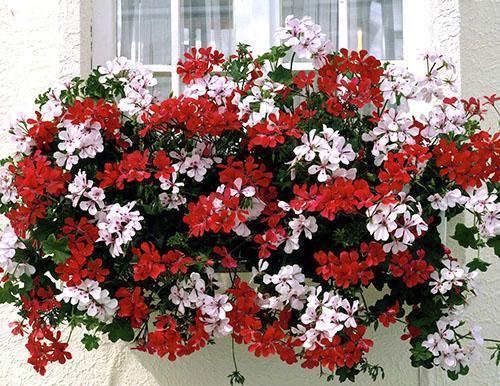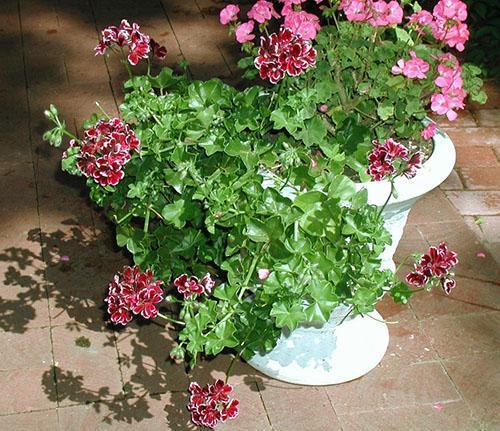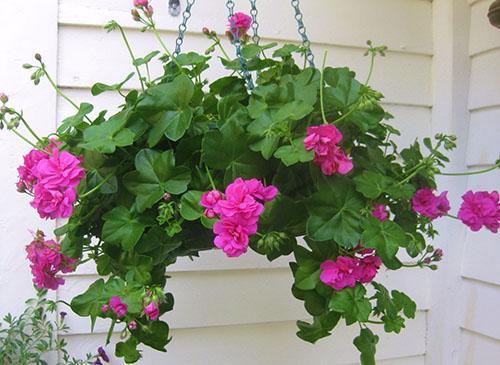Learning to breed and care for ampelous pelargonium
 With the onset of warmth, the streets of cities and small settlements, household plots and balconies are transformed due to the lush bloom of a variety of decorative crops. Ampel Pelargonium, as in the photo, with spectacular cascading shoots and inflorescences consisting of a dozen flowers, occupies one of the first places among plants used for landscaping.
With the onset of warmth, the streets of cities and small settlements, household plots and balconies are transformed due to the lush bloom of a variety of decorative crops. Ampel Pelargonium, as in the photo, with spectacular cascading shoots and inflorescences consisting of a dozen flowers, occupies one of the first places among plants used for landscaping.
Like other types of pelargonium, the ampelous or ivy-leaved variety was first discovered in southern Africa, but the unpretentious and responsive plant quickly won the love of flower growers in all corners of the world.
Today, many spectacular varieties have been bred with different shapes and colors of flowers, green and variegated leaves. All of them have common features in common:
- graceful, freely falling stems, reaching 90 cm in length;
- smooth five-lobed leaves of a characteristic shape, which gave the plant one of the names;
- located on elongated peduncles and collected in umbellate inflorescences, simple or double flowers.

Home care for pelargonium
All varieties of pelargoniums, not excluding ampelous varieties, love light, with a lack of which they can significantly reduce the duration of flowering and not show themselves in all their glory.
 When grown at home, caring for pelargonium necessarily involves creating a long daylight hours for the plant:
When grown at home, caring for pelargonium necessarily involves creating a long daylight hours for the plant:
- In summer, the pots are exposed to the lightest warm windows or planted in similar parts of the garden, but they are covered from the scorching rays in especially hot days and hours.
- In winter, autumn and early spring, the necessary artificial lighting.
In the summer months, feel comfortable, as in the photo, ampelous pelargonium will be at a temperature of 20-25 ° C. On hotter days, the plants do not suffer too much, the main thing is to increase watering and make sure that no traces of sunburn appear on the foliage.
In winter, pelargonium requires a long, up to three months, dormant period, when for the bushes, without reducing lighting, they create temperature conditions in the range of 10-15 ° C and reduce the intensity of irrigation. If these conditions are not met, the leaves on pelargonium will turn yellow, and in the spring you can not wait for flowering at all.
A rapidly developing culture requires a loose nutritious soil in which moisture is well retained, but the roots do not suffer from decay.
For planting ampel pelargoniums, you can use a mixture of equal shares of garden soil, cleared of coarse inclusions of peat and sand, but the unpretentious plant also feels great in ready-made soils for ornamental crops, to which a little sand or vermiculite is added.
 In order for ampelous pelargonium to bloom profusely, many growers try to limit the plant in growth, planting it in a pot that is only a couple of centimeters in diameter larger than the root system. The plant signals the need for transplantation with a completely entwined earthen lump. In addition, the answer to the question: "Why do the leaves turn yellow to pelargonium?" sometimes it just becomes necessary to replace the pot.
In order for ampelous pelargonium to bloom profusely, many growers try to limit the plant in growth, planting it in a pot that is only a couple of centimeters in diameter larger than the root system. The plant signals the need for transplantation with a completely entwined earthen lump. In addition, the answer to the question: "Why do the leaves turn yellow to pelargonium?" sometimes it just becomes necessary to replace the pot.
For an adult bush of medium size, a container with a diameter of 10–12 cm is quite suitable, while connoisseurs advise choosing pots made of porous ceramics that allow air to pass through and prevent roots sensitive to excess moisture from rotting.
Ampel varieties can be planted in one flowerpot or balcony box, which will only add decorative plantings and give charm to the veranda, balcony or windowsill.
Plant formation
 From February to March, flower growers pinch the shoots of pelargonium. This procedure is designed to:
From February to March, flower growers pinch the shoots of pelargonium. This procedure is designed to:
- form the crown of the plant;
- stimulate the growth of new shoots;
- rejuvenate the bush;
- lay the foundations for the next bloom.
It is at the end of winter, when daylight arrives, that crown formation gives the best results and is the most painless. When carrying out the formation, it must be borne in mind that the effective form of ampelous pelargonium is provided by long shoots of the lower tier.
When pinching:
- remove old shoots, leaving two or three lower buds;
- pinch the young upper stems;
- remove all shoots growing from the upper sinuses of the existing stems.
If regular pruning is carried out in early spring, then you need to constantly cut out weak shoots, for some reason yellowed leaves of pelargonium and wilted peduncles. This will allow you not to weaken the plant and maintain its strength for growth and flowering.
Top dressing of ampelous pelargonium for lush flowering
 After pruning, as well as during active vegetation, the plants must be fed by introducing liquid mineral and organic fertilizers... And here you need to remember that the quality of flowering largely depends on the choice of the mixture.
After pruning, as well as during active vegetation, the plants must be fed by introducing liquid mineral and organic fertilizers... And here you need to remember that the quality of flowering largely depends on the choice of the mixture.
Nitrogen stimulates the growth of greenery and shoots. Sometimes, complaining that for some reason the leaves turned yellow on pelargonium, or the flower refuses to form buds, the growers themselves are to blame for the problem, overfeeding the plants with nitrogen.
The "diet" for the formation of lush inflorescences is potassium and phosphorus. In addition, magnesium sulfate is a good help for the flowering of pelargonium. It turns out that the substance containing magnesium and sulfur not only has a beneficial effect on the quality of the harvest of garden crops, but also contributes to the formation of lush numerous inflorescences on all varieties of geraniums.
Fertilizers for pelargonium are applied from spring to the beginning of the "wintering" period, when the plants are rearranged to cool.
Reproduction using seeds
 Florists are convinced that pelargonium grown from seeds is more resistant to diseases, hardened better and tolerates drafts and temperature extremes. Sowing is carried out in the second half of winter, after having disinfected and moistened the soil, on which the seeds are laid. After the seed is covered with a thin layer of soil, the surface is carefully moistened again.
Florists are convinced that pelargonium grown from seeds is more resistant to diseases, hardened better and tolerates drafts and temperature extremes. Sowing is carried out in the second half of winter, after having disinfected and moistened the soil, on which the seeds are laid. After the seed is covered with a thin layer of soil, the surface is carefully moistened again.
It is best to use a spray gun for watering crops, which does not give a powerful jet that buries the seeds.
The container with the crops is covered with a film, with which condensation is removed daily until the sprouts appear, and placed in a room where the temperature is maintained from 20 to 24 ° C. Young, obtained from pelargonium seeds, dive on flocks of two true leaves, and further cultivation is carried out at a temperature of 16-18 ° C. The bushes are ready to "move" to a permanent place at the age of 1.5–2 months.
How is the grafting of pelargonium
 Despite the ease of care and reproduction of ampelous pelargonium by seeds, another method is more often used - cuttings.
Despite the ease of care and reproduction of ampelous pelargonium by seeds, another method is more often used - cuttings.
Reproduction by cuttings has an undeniable advantage - daughter plants retain all the properties and appearance of the mother pelargonium, which is extremely important in relation to varietal bushes.
The tops of young vertical shoots, 7–10 cm long and with two pairs of opened leaves, are used as planting material. The best time for harvesting cuttings is from February to March, as well as from the second half of July to the end of August.In this case, reproduction of ampelous pelargonium and planting care is the simplest and most effective.
The cut pieces of the stems are left at room temperature for several hours so that the cut treated with coal powder dries up, then the cuttings are planted in a wet peat-sandy soil mixture, deepening 3 cm.
 For better rooting, pelargonium cuttings need:
For better rooting, pelargonium cuttings need:
- temperature is about 20-22 ° C;
- moderate soil moisture, so as not to cause rotting of the lower part of the stem.
After a month, young plants acquire their own roots and they can be transplanted into containers with a diameter of 8-10 cm. Further care for pelargonium at home does not differ from what adult plants receive, and the young bushes will begin flowering in the coming spring.